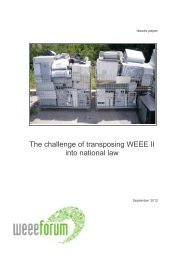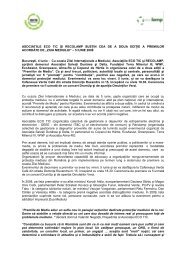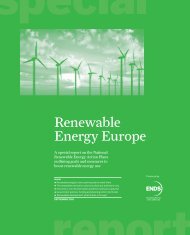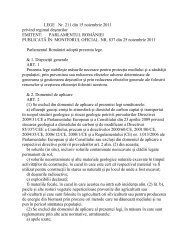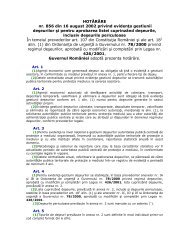PCB's in Small Capacitors from Waste Electrical and ... - Ecotic
PCB's in Small Capacitors from Waste Electrical and ... - Ecotic
PCB's in Small Capacitors from Waste Electrical and ... - Ecotic
You also want an ePaper? Increase the reach of your titles
YUMPU automatically turns print PDFs into web optimized ePapers that Google loves.
PCB’s <strong>in</strong> <strong>Small</strong> <strong>Capacitors</strong> <strong>from</strong> <strong>Waste</strong> <strong>Electrical</strong> <strong>and</strong> Electronic Equipments<br />
5 F<strong>in</strong>al Conclusions <strong>and</strong> Measures<br />
5.1 F<strong>in</strong>al Conclusions<br />
From the results of the <strong>in</strong>vestigations <strong>in</strong>to PCB content<br />
<strong>and</strong> further substances <strong>in</strong> small capacitors <strong>from</strong> electrical<br />
<strong>and</strong> electronic equipments, the follow<strong>in</strong>g conclusions<br />
may be drawn:<br />
• It may be assumed that already more than 99% of the<br />
PCB capacitors <strong>from</strong> WEEE, respectively, were disposed<br />
of.<br />
• <strong>Small</strong> capacitors <strong>from</strong> ballasts <strong>in</strong> fl uorescent tube<br />
lamps <strong>and</strong> typical mixtures of large household appliances<br />
are, as before, <strong>in</strong>clud<strong>in</strong>g relevant amounts of<br />
PCB’s. About 6–60 % or 1–4 %, respectively, of these<br />
capacitors still conta<strong>in</strong> PCB’s. For the two device categories<br />
of 2006, the PCB emission potential represents<br />
about 400 – 4’300 kg /a.<br />
• In lesser quantities, small capacitors <strong>from</strong> IT/CE<br />
(> 2.5 cm) show also a PCB fl ow. In 2006, the PCB<br />
fl o w adds up 40 – 60 kg /a, reach<strong>in</strong>g about 1 % of the<br />
estimated total fl ow <strong>from</strong> electrical <strong>and</strong> electronic<br />
equipments.<br />
• Also small capacitors <strong>in</strong> waste small household appliances<br />
hold PCB <strong>in</strong> small amounts. With about 20 kg /a,<br />
the PCB emission potential of 2006 is irrelevant.<br />
• No PCB’s could be traced <strong>in</strong> small capacitors <strong>from</strong><br />
cool<strong>in</strong>g <strong>and</strong> freez<strong>in</strong>g appliances, IT/CE (< 2.5 cm), <strong>and</strong><br />
<strong>from</strong> un<strong>in</strong>terruptible power supply systems. Their annual<br />
emission potential is also negligible.<br />
• <strong>Small</strong> capacitors <strong>from</strong> microwave devices are as good<br />
as PCB-free. 18 % biphenyls <strong>and</strong> 0.2 % phthalates<br />
were identifi ed <strong>in</strong> the samples.<br />
• A GC-MS full scan analysis for identify<strong>in</strong>g compounds<br />
<strong>and</strong> substance classes <strong>in</strong> the extracts revealed the<br />
presence of a large number of matters <strong>in</strong> most of the<br />
samples. Some of the identifi ed compounds must be<br />
classifi ed as environmentally hazardous or harmful to<br />
health. Simultaneously, most of the samples show <strong>in</strong>creased<br />
PCB values <strong>and</strong> are to be considered, holistically,<br />
as hazardous for environment <strong>and</strong> health. Namely<br />
small capacitors <strong>from</strong> large household appliances (N° 1<br />
<strong>and</strong> 2), small household appliances (N° 3), lamps (N° 6),<br />
IT/CE (N° 8, 9) are concerned.<br />
• Analys<strong>in</strong>g shredded small capacitors of highly vary<strong>in</strong>g<br />
designs is fastidious. Error sources <strong>and</strong> uncerta<strong>in</strong>ties<br />
are obviously important. The PCB content of the same<br />
bulk sample is vary<strong>in</strong>g much between the three specialised<br />
laboratories, notably with high concentrations<br />
around factor 10. The essential sources of error are to<br />
be looked for among the extraction methods <strong>and</strong> the<br />
splitt<strong>in</strong>g of congeners.<br />
5.2 Recommendations<br />
• All the appropriate measures must be taken at once to<br />
<strong>in</strong>crease the controlled disposal of ballasts <strong>in</strong> fl uorescent<br />
tube lamps, ma<strong>in</strong>ly <strong>from</strong> the B2B channel. It implies that<br />
capacitors are consequently removed <strong>from</strong> ballasts, also<br />
if solidly welded. Thereby, several dozen tons PCB’s can<br />
be kept away <strong>from</strong> the environment.<br />
• The Regulations <strong>and</strong> Directives of the system operators<br />
SENS <strong>and</strong> SWICO do not need to be modifi ed regard<strong>in</strong>g<br />
the removal of capacitors <strong>from</strong> electrical <strong>and</strong> electronic<br />
equipments. For the capacitors <strong>and</strong> the dimensional criterion,<br />
the rules <strong>in</strong> Annex II of the WEEE Directive also<br />
make sense. By way of precaution, they allow to avoid<br />
probably 10 – 20 tons per year of predom<strong>in</strong>antly environmentally<br />
hazardous matters.<br />
• When analys<strong>in</strong>g PCB’s <strong>in</strong> mixtures of old capacitors, the<br />
analytical methods require special attention. Control <strong>and</strong><br />
quality assur<strong>in</strong>g measures are essential with regard to<br />
the extraction of PCB’s <strong>and</strong> the splitt<strong>in</strong>g of congeners.<br />
The values with PCB contents <strong>in</strong> old capacitor mixtures<br />
found <strong>in</strong> literature are to be <strong>in</strong>terpreted with the appropriated<br />
precautions. Current imprecisions of ± 20 – 30 %<br />
may be exceeded considerably with<strong>in</strong> this dem<strong>and</strong><strong>in</strong>g<br />
matrix, especially <strong>in</strong> case of high concentrations.<br />
• In a follow-up project, PCB substitutes <strong>and</strong> electrolytes<br />
are to be studied more specifi cally <strong>and</strong> quantitatively,<br />
follow<strong>in</strong>g the orig<strong>in</strong> of the capacitors <strong>and</strong> their category<br />
of devices. The results of the said follow-up project shall<br />
enable risk estimations <strong>and</strong> cost-utility considerations<br />
for the removal of capacitors.<br />
• Due to the fact that the share of PCB-conta<strong>in</strong><strong>in</strong>g capacitors,<br />
the dielectrics used <strong>and</strong> the composition of the<br />
electrolytes are chang<strong>in</strong>g with time, the <strong>in</strong>vestigations<br />
should be repeated <strong>in</strong> a few years (follow-up analyses <strong>in</strong><br />
2010, for example), so as to grant a safe, wise h<strong>and</strong>l<strong>in</strong>g<br />
of small capacitors <strong>from</strong> electrical <strong>and</strong> electronic equipments.<br />
18



